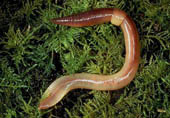|
Worms are invertebrates with a segmented and long slender body and no limbs. Worms are found on almost habits in the world, including sea and freshwater.
Worms like the taenia are parasites to man and livestock. Others like the earthworm are very useful to man under the ecological point of view.
Leeches and lugworms are worms, too.

LEARN ABOUT EARTHWORMS
Earthworms are the most highly developped worms. The body of earthworms is divided into one or more rings or segments. Earthworms can live in sea and freshwater and also in the soil.
Earthworms have the particularity of regenerating body segments that were amputated, and they use this characteristic also for reproduction purposes.
Earthworms have both male and female sexes, but the eggs must be fertilized by another earthworm.

Earthworm |

African giant earthworm |

Blue giant earthworm |
How do earthworms breathe?
Earthworms do not have lungs nor gills, they breath through their moist skin.
How do eartmorms travel?
Each body segment has four pairs of bristle-like hairs called setae that help the earthworm move.
What do earthworms eat?
They eat dirt, leaf bits and remains of dead animals in the soil.
What size can earthworms reach?
Earthworms range in length from a few centimeters/inches to a few meters/feet.
Why are earthworms so important to mother nature and men?
They are very important because they spend most of their time digging tunnels and galleries in the soil, and they eat dead leaves and dead animal matter. And when doing this
1. their droppings recycle nutrients and nourish the soil, rendering it more productive.
2. the tunnels and galleries they produce as they move through the soil serves to turn the soil and to give it valuable air.
Aristotle, a very clever and famous Greek, used to say that earthworms were the intestines of the soil.
|




